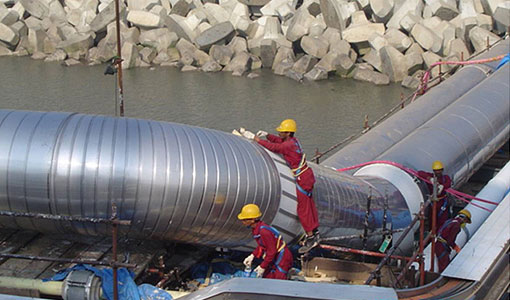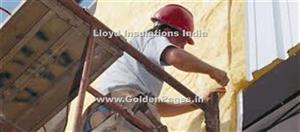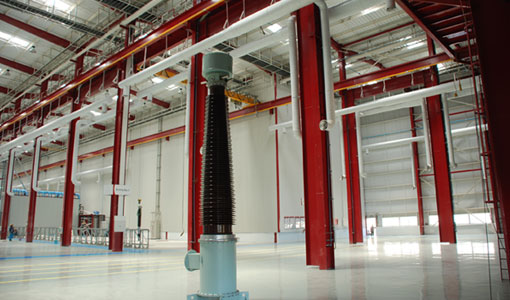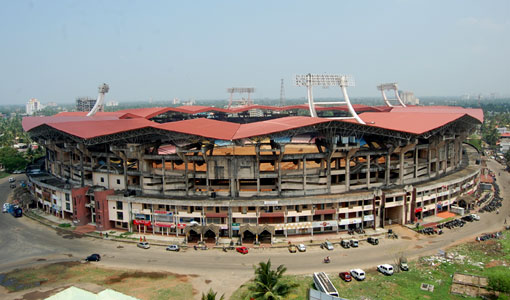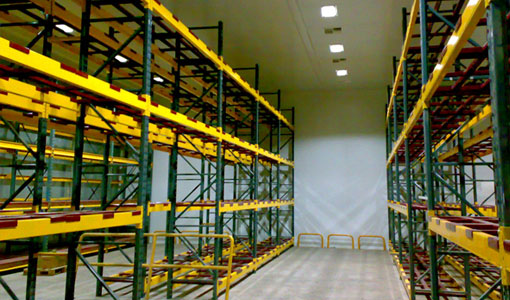LLOYD INSULATIONS INDIA LTD.
Featured Products
Highest quality standards are achieved through the implementations of latest technology, decades of experience and everlasting moral values , which have helped us to retain our customers as well as multiply them.
Welcome to LLOYD INSULATIONS INDIA LTD.
Pre Insulated Sandwich Panels
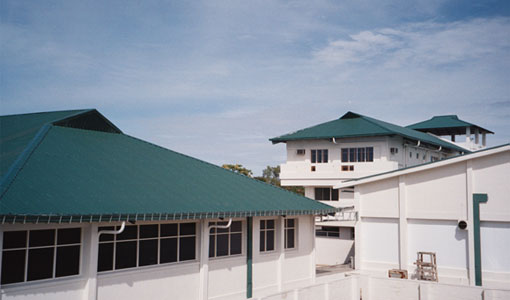
Buildings of all types require external fabrics which are capable of facing external exposure conditions while resisting various loads that are incident on them. External conditions include high or low ambient temperatures, high incidence of solar radiation (including ultraviolet rays), attack by environmental media (some of which can be corrosive) and seasonal exposure to rain, snow or sandstorm situations. Loads incident on external fabrics include wind loads, seismic loads, live loads faced during usage of the building and many collateral loads such as loads due to mechanical equipment and services directly mounted on the building fabric.
Metal faced pre-insulated sandwich panels combine every feature required to meet the above exposure conditions while offering high thermal insulation value extraordinarily high structural strengths to span large distances between supporting structural members.
Apart from external Walls and roofs, every building would require partitioning of internal spaces. Metal faced sandwich panels provide simple and easy-to-erect solutions for all such applications.
Many special facilities like Cold Stores require high level of thermal and structural integrity coupled with high thermal insulation values to meet specific low temperature conditions.
Many manufacturing facilities (in Pharma, Electronics, Precision machining, Paint shops) demand temperature controlled interiors. Thermally insulated envelopes have become a necessity for all such applications.
Lloyd Insulations (India) Ltd. has a comprehensive range pre-insulated sandwich panels with a variety of outer finishes and insulating cores ranging from high efficiency polyurethane / polyisocyanurate to totally fire-safe Rock Wool insulation.
To meet aggressive conditions, metal facings are pre-painted with a variety of finishes over hot dip galvanized / galvalume steel. Architectural coatings include polyester, poly vinyl di fluoride (PVDF/PVF2) many other options in a wide range of colours.
In the latest manufacturing unit of LLOYDS, these panels are produced in extended lengths featuring continuous production processes which are probably the most advanced in the world. The rigid urethane foams featured in this plant are 100% free from CFC or HCFC, which are known Ozone depleting substances.
Rockwool core incorporated in these special panels are of structural grade and have the unique “lamella” construction to offer extraordinarily high compressive strengths while building in highest fire safety among all panel systems.
Lloyd Insulations (I) Ltd. have a system of providing total solutions including complete responsibility for detailing and installation in field. All connected activities like design, detailing and ancillary material selection are done to result in easy and fast realization of panel work with every small detail taken into account.
Lloyd Insulations (I) Ltd. have made it a practice to keep upgrading manufacturing technologies so that speed, cost and high functionality are built into every system offered to its customers.
Polyurethane Sandwich Panel production processes and their effect on Cold Store panel performance- A brief overview.
Polyurethane Sandwich Panels are specified and used in a variety of applications-
- Insulated roofs in commercial and Industrial buildings feature where an external profiled sheet and internal plain sheet with an integral insulation core. In Between joints of panels, precisely details lapping system in profiled facing is designed to prevent water and vapour leaks. The external sheet is similar to the profiled sheets normally used in metal roofing arrangements. The inner sheeting, although referred to as plain, does have a minor profile- featuring what are known as 'light cutting grooves'.
- Siding systems for walls where the facings are selected according to the architectural elevation design follow the same configuration as the one featured for the roof in its simplest form. However, as per designers, choice various external skin of the panel are offered to various aesthetical Designer profiles.
Normally, spaces are air conditioned in building application for comfort and hence temperature difference between the two faces is nominal. Importance is given to water and air tightness of the external face in all cases. - Technical facilities like Cold Storages, and Frozen Chambers demand larger temperature differences between the two faces of panels than in building applications. Metallic faces for these applications are generally flat with joints in insulation featuring a 'male and female' profiled jointing system. Joints are either positively interlocked or with liquid injected integrity . Very high importance is given to sealing - both in the butt joint between the PU insulation of adjoining panels as well as the vapour tight joint of the external steel.
In cold and frozen store applications, these features become very important, apart from the requirement of higher thermal efficiency of insulation per se.
In the Western World, in terms of millions of square meters of panels produced and used, the market is dominated by building roof and siding applications, In India, use of sandwich panels is evenly balanced between the two end uses presently. However, with the advent of Electronic, Pharma and precision manufacturing activities, sandwich Panels are assuming high relevance in building construction.
Production Processes:
Sandwich panels with rigid facings are produced using two variants in production techniques, viz:
- Continuous production process and
- Semi Discontinuous production process.
Production aspects in either process are aimed at producing products with similar end-use features. Although equipment may look drastically different, the basic foaming techniques and process steps featured in foam production are very similar.
1. Continuous Panel Production:
Continuous panel making process involves all operations starting from forming sheet metal profiles required for both faces, creation of Polyurethane foam (or Lamella Rockwool), creation of the panel to panel joining profile detail, curing of the composite and final cutting of product to length all along a continuous conveyorised line.
Two separate Roll formers for the two metal facings start from coils of sheet metal and issue out the two facings, which move to the moulding area. A pair of moving side belts of a flexible material on either side creates the side closures for retaining the liquid chemicals and for the rigid foam to fill. These side belt also acts as moulds to generate the edge profile. The top and bottom sheets are supported continuously by a slat and side chair conveyor precision with plattens keeping the sheets pressed against the side belts. Thickness of the panel is determined by the gap between the two platten forces and the vertical height of the side belt featured in each case. The two sheets and the two side belts enclose and create the moving hollow space, which is the 'mould'.
Urethane chemicals which are carefully selected are injected as precisely metered individual streams, blended into one streams and distributed evenly. Where needed, the inner surface of profiled metal is given a 'CORONA' treatment to improve bonding strengths. The chemical system is delivered in to the 'mould' by an oscillating manifold on which delivery nozzles are mounted at equal spacing. These lines of the liquid chemical mixture slowly find their level over the bottom sheet evenly. They start reacting after the 'cream time' is reached. The foam then starts to rise, till the 'rise time' is completed. The top surface of the foam starts to adhere to the bottom surface of the top sheet after the 'tack-free' time is attained. All these reactions proceed even as the whole 'mould' is moving along.
The Pressure platten conveyors over the two sheets along with the side belts are long enough to keep the “Sandwich “ in closed state for a sufficiently long duration so that the finished panels is fully curved in all respects before it leaves this crucial section of the line.
It is to be noted that the density of foam selected for all sandwich panel making processes are sufficiently higher than the free-rise density of the foams. This is required to ensure that the foam fills all the nooks and corners of the 'mould'. The finished panel is cut to length by microprocessor controlled cross cut saws- cutting the sandwich assembly two sheet facings and the foam together.
The above is the brief process used, which is specifically tailor made for production of building and cold store panels of extra ordinary uniformity at very production speeds.
2. Discontinuous Panel making process:
In this production process, the principle of panel production is exactly similar to the above continuous process. However, all the activities are conducted in a stationary single station, as against a moving arrangement described above.
The equipment used is known as the 'Panel Press', which features a vertical hydraulic ram of the length and width of the layest panel desired to be produced.
Profiling of the two faces of metallic facing (or any other facing like FRP, PVC etc) is done as an 'off line' processes and brought to and stacked on either end of the press. The 'mould' is created as follows:
The base on which the bottom facing is placed is a precisely machined flat Platten equipped with a built in heating system. Sides of the mould are made of machined Aluminum extrusions (jigs), profiled to the male and female joint features desired. These jigs are specific to each thickness of panel being produced. Jigs also feature accurately positioned fixtures to mount “CAMLOCK” components, which get embedded in to the foam later. When the pre-profiled top and bottom facing sheets are placed in this mould with special spacers, we create a hollow space which is ready for chemical injection complete.
This complete pre-assembly is moved laterally into the 'daylights' of the press by a positioning actuator. A heavy ram, which is a precision machined guided block, closes the mould tightly and holds the 'mould' firmly. The temperature controlled heated plattens keep the mould at the optimum reaction temperature.
Through many nozzles provided on the sides of the 'mould', PU chemicals mix is injected to precise volume as per settings in the microprocessor controlled delivery head. The liquid mix finds its level well before the 'cream time' of the chemicals is reached. The foaming reaction starts and the foam rise gradually to fill the nooks and corners of the mould. The rising of the foam is complete well before the 'tack-free' time, when the adhesion to the sheets starts- i.e., well after the foam has filled the 'mould'. The assembly is held in position, in the preheated mould till after the 'mould release' time has elapsed.
Maintenance of each of the time elements of the process is achieved using the microprocessor assisted control system.
The above describes a 'single panel' manufacturing process. However, our modern panel presses feature 'multiple daylight', double acting machines involving creation of two, four, six or more panels in one operation.
As explained earlier, each of the above processes are engineered to result in optimum finished product features. However, there are differences in respect of some features and limitations in each. These are discussed as follows:-
- As the name implies, Continuous panel plants produce panels continuously, with highest uniformity of properties and dimensions which can be cut to longer lengths. However, transportation limitation may restrict the length to 12 mtr. (Discontinuous panel plants are also able to deliver such lengths.)
- The main aspect of a continuous plant is the speed of production- being continuous; the manufacture of panels can be theoretically speeded up using faster conveyors. The longer process lines employed in our plants ensure that the panel moulds retains the panels together till the various process times are ensured comfortably before reaching the cooling curing section of the plant, even at the fastest speed.
- Panels made in continuous plants show higher uniformity in foam qualities and better architectural flatness.
- Older Panel presses, which had limited lengths of 6mtr (max), have now been replaced by machines with a mould length of 12.5 m. Hence, these machines manufacture panels to the longest transportable lengths today, thereby removing this limitation.
- Multiple daylight and double acting panel presses have greatly increased the overall production speeds and capacities. Multiple daylights permit more than one panel pre-assembly to be closed at a time. Double acting arrangement features a central ram, which can move up to close and hold the top array of moulds, and in its movement downwards, to close and hold the bottom arrays. Precision machined platterns have improved the aesthetics of these panels as well.
This process is described as 'semi discontinuous', and, in terms of speed of production, very closely match with that of some of the continuous lines, within a more compact production shop. - Semi discontinuous panels press concept facilitates production of panels featuring “Cam Locks” to interlock panels together for additional integrity. This is also gives the advantage of producing panels of widths which may be non standard in a mix of sizes as may be required.
Panel manufacturing capability available to us in the LLOYDPANEL system meets and exceeds the duty requirements of all building designs and those of any scientifically designed and constructed cold storage. The most versatile discontinuous plants at Pithampur and Baddi along with arguably the most modern continuous panel plant in the world at cheyyar, Tamil Nadu give the company a very large and geographically distribution base. All the facilities also incorporate in-house 'state of art' laboratory facilities for testing all significant properties, including Thermal conductivity, Compressive / Shear / Flexural strengths, Thermal stability and all relevant PU foam tests.
Our plants are ISO 9000 accreditated and produce products to meet all International Standards. We have had the privilege of meeting and exceeding the standards prescribed by UNILEVER, BECHTEL, MICHELIN, BROWN & ROOT, FERRARO ROCHER, NDDB, and many such international users.
Needless to state, we have the largest experience in Field erection and finishing of Lloyd panel System country-wide through dedicated crews to take full responsibility for correct implementation, finishing and commissioning, speedily and to prescribed standards.
Our technical and contracting capabilities are well known to important customers and we normally spare no efforts to place them totally at their disposal of project implementing teams.
Our Vision
* To embrace new technologies and methods. * To give unsurpassed products and services to the clients. * To constantly look for improvement and changes.



